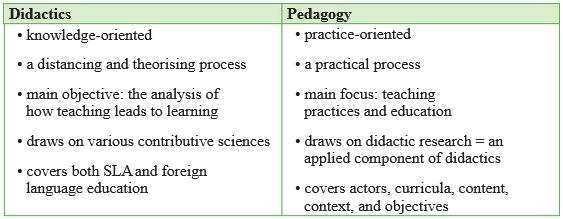
Teaching is educating students on their requirements and the subject matter by utilizing a variety of academic methodologies. It is beneficial to comprehend didactics and how it differs from pedagogy if you are a teacher or intend to become one. If you are someone who is pursuing or has already completed any kind of teacher training courses, you must be thinking about what didactics and pedagogy mean and what the major differences are. Here is everything you should know.
What Is Didactic Teaching?
Direct instruction from the instructor to the students is highly valued in the didactic teaching approach. When using a didactic teaching strategy, the instructor usually assumes the position of the principal knowledge provider and provides the students with information in an orderly and systematic way. This method is frequently linked to an older, teacher-centered educational paradigm.
The orderly and transparent presentation of knowledge is one of the main features of didactic instruction. Instructors who employ this strategy often give their pupils a curriculum that is well-organized and has clearly stated learning objectives. To transfer knowledge and information to the students, teachers frequently use lectures, presentations, and demonstrations.
What Is A Didactic Teaching Approach?
Some of the crucial elements that define the didactic teaching approach include:
Didactic instruction frequently makes use of a well-planned and organized curriculum. Lesson plans are created by teachers, outlining the subjects and the order in which they will be covered.
A didactic approach places a strong emphasis on the instructor as the main figure in the classroom. They are in charge of informing students, elucidating ideas, and overseeing the educational process.
A didactic method has well-defined learning objectives. Specific knowledge and abilities are required of students, and examinations are frequently employed to gauge how well they comprehend and retain the subject matter.
In a didactic classroom, students usually have less freedom and self-direction. The emphasis is on learning what the teacher has to say, with little chance for free-form thought or independent research.
Major Differences Between Pedagogy And Didactics

If you are trying to figure out the major differences between didactics and pedagogy, here are a few:
1. Learner-Centered Vs. Teacher-Centered
When teaching didactically, the instructor takes center stage and serves as the main conduit for information. They decide what, when, and how students will learn, frequently using conventional techniques like lectures and scheduled classes. Conversely, a pedagogy method moves the emphasis from the instructor to the pupils.
It emphasizes identifying each student's unique learning style and requirements while promoting critical thinking, active engagement, and teamwork. Learner-centered classrooms provide a more dynamic and engaging learning environment by encouraging student autonomy and personal responsibility for learning.
2. The How Vs. The Why Approach
A key distinction between pedagogy and didactics is that the former takes into account the reasons why educating students is vital, while the latter frequently concentrates more on how to instruct and teach students. The word ‘how’ mostly refers to the useful methods and approaches teachers use to impart knowledge and skills to their students.
It covers the practical aspects of teaching, such as lesson design, assessment techniques, and delivery tactics. On the other hand, asking ‘why’ draws attention to the underlying meaning and intent of what is being taught. It pushes students to probe, dissect, and make connections between ideas to get a thorough comprehension of the material and its application to real-world situations.
3. Content Vs. Strategy
Pedagogical instructors frequently pay more attention to how they can use the tools, whereas didactic teachers typically concentrate more on developing the curriculum's content. a variety of resources and methods for teaching pupils. The material or subject matter that pupils are required to study is referred to as ‘content.’
This includes the knowledge, abilities, and facts that are considered fundamental to a certain curriculum. On the other hand, ‘strategy’ refers to the techniques and procedures teachers use to help their pupils understand the material. It includes a broad variety of pedagogical options, such as instructional strategies, lesson planning, assessment tools, and classroom management.
4. Process Oriented Vs. Knowledge Oriented
The pedagogical approach concentrates on the learning process and the attitude of the learner during it, whereas the didactic teaching style concentrates on the dissemination of knowledge. Getting precise data and information is the most important goal of a knowledge-oriented strategy. It places a strong emphasis on teaching pupils what they should know while emphasizing memory and comprehension of existing information.
On the other hand, a process-oriented approach puts more emphasis on how students acquire and use their information. It places a high value on critical thinking, problem-solving abilities, and using knowledge in practical settings. Through active involvement with the learning process, this method seeks to improve students' capacities to not just absorb information but also to evaluate, synthesize, and generate new knowledge.
5. Specific Teaching Strategies
A wide variety of specialized teaching techniques, each designed to fulfill unique learning objectives and satisfy the requirements of various students, are included in effective teaching. For instance, lectures are a type of didactic instruction where the instructor presents material orally, which makes them appropriate for imparting fundamental knowledge.
Conversely, discussions as a pedagogical strategy encourage students' active participation and idea exchange. Experiments and projects that include hands-on work give students real-world learning experiences. Students who engage in case study learning can apply critical thinking and problem-solving techniques to real-world situations.
Didactics Or Pedagogy?
Understanding the differences between pedagogy and didactic teaching will help you better understand the complex world of education. The actual strategies and methods of teaching are the focus of didactics, whereas pedagogy delves into the deeper philosophical and sociological aspects, asking the 'why' behind educational processes. So, enroll yourself in Teacher Training Courses, understand the different approaches, and embark on your journey as a teacher.
We believe education should be accessible for everyone. That’s why we don’t charge for our blogs. Find the right course that will help you in your career with us, contact us at - 8000180858. You can mail us at act@asiancollegeofteachers.com.